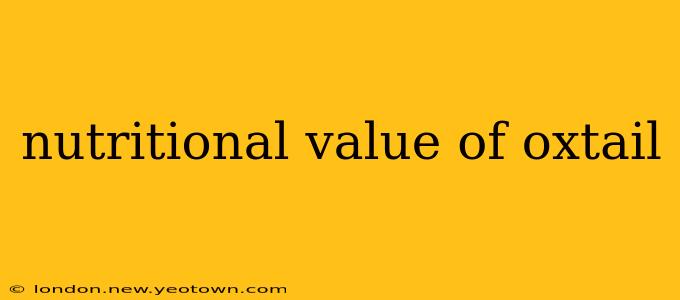Oxtail. The name conjures images of rich stews, simmering slowly for hours, releasing their deeply savory flavors. But beyond its culinary appeal, oxtail boasts a surprising nutritional profile that deserves a closer look. It's not just a delicious ingredient; it's a source of essential nutrients often overlooked in modern diets.
This isn't your typical chicken breast – oxtail offers a unique blend of nutrients, making it a valuable addition to a balanced diet, though moderation is key due to its fat content. Let's delve into the specifics.
What are the key nutrients in oxtail?
Oxtail is a powerhouse of protein, providing a substantial amount per serving. Think of it as a slow-release energy source, keeping you feeling full and satisfied for longer. Beyond protein, it’s a good source of several essential vitamins and minerals, including:
- Iron: Crucial for carrying oxygen throughout the body, preventing anemia. Oxtail's iron is particularly valuable because it's heme iron, a form more readily absorbed by the body than non-heme iron found in plant-based sources.
- Vitamin B12: Essential for nerve function, red blood cell formation, and DNA synthesis. This is particularly important for vegetarians and vegans, who may struggle to obtain sufficient B12 from their diets.
- Niacin (Vitamin B3): Plays a vital role in energy metabolism and maintaining healthy skin.
- Zinc: Supports immune function, wound healing, and cell growth.
- Phosphorus: Essential for building and maintaining strong bones and teeth.
Is oxtail high in cholesterol?
Yes, oxtail is relatively high in cholesterol and saturated fat. This is a crucial point to consider, particularly for individuals with pre-existing health conditions like high cholesterol or heart disease. Moderation is key. While oxtail offers beneficial nutrients, consuming it frequently or in large portions could negatively impact your cholesterol levels.
How does the nutritional value of oxtail compare to other meats?
Compared to leaner cuts of meat like chicken breast or fish, oxtail has a higher fat content. However, the unique nutrient profile, especially its high iron and B12 content, distinguishes it. It's not a direct replacement for leaner meats, but rather a valuable addition to a varied diet, consumed in moderation.
What are the health benefits of eating oxtail?
While high in fat, oxtail's nutritional benefits shouldn't be dismissed entirely. The high protein content aids muscle building and repair, while the vitamins and minerals support various bodily functions. The collagen present in oxtail also contributes to healthy skin, hair, and joints. However, remember to consume it as part of a balanced diet, not as a primary source of nutrients.
How can I incorporate oxtail into a healthy diet?
The key is moderation. Don't make oxtail a staple in your diet, but rather enjoy it occasionally as a treat. Choose leaner cooking methods like braising or stewing, which allow the fat to render away. Pair it with plenty of vegetables to create a well-rounded and nutritious meal. Consider trimming visible fat before cooking to further reduce the saturated fat intake.
Is oxtail good for weight loss?
Due to its high fat content, oxtail is not ideal for weight loss. While it provides protein, the caloric density is quite high, potentially hindering weight loss efforts. Opt for leaner protein sources if weight management is your primary goal.
Oxtail, with its rich flavor and nutritional complexity, is a fascinating ingredient. By understanding its nutritional profile and consuming it mindfully, you can enjoy its culinary delights while also benefiting from its unique nutritional contributions. Remember, balance and moderation are key to a healthy diet.

